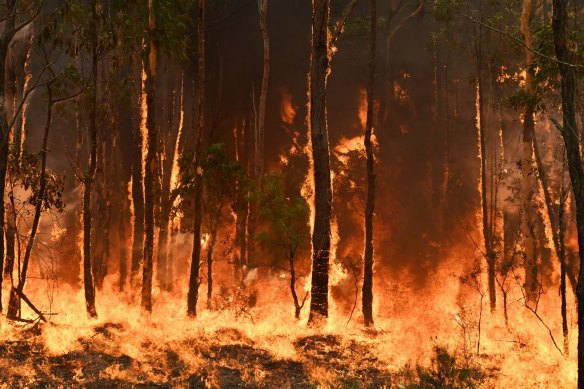BMP Insights: Secret Parts and Advantages of a Bushfire Management Plan
BMP Insights: Secret Parts and Advantages of a Bushfire Management Plan
Blog Article
The Importance of Bushfire Management in Fire Protection
In the world of fire protection, the significance of effective bushfire management can not be underrated. As neighborhoods worldwide grapple with enhancing instances of wildfires, the proactive technique to avoid and alleviating these natural catastrophes via critical bushfire administration techniques has become an important element. Past the instant risk to human life and property, the interaction in between bushfire administration and environmental preservation, community involvement, and climate modification positions intricate difficulties that need comprehensive solutions.
Relevance of Proactive Bushfire Prevention
Proactive bushfire prevention techniques are important in reducing the devastating influences of wildfires on ecological communities and neighborhoods. One essential aspect of aggressive bushfire avoidance is fuel management.
Enlightening the public on fire security methods and promoting area recognition concerning the importance of bushfire avoidance are essential parts of proactive strategies. Eventually, aggressive bushfire prevention plays a substantial duty in protecting communities and ecosystems from the devastating impacts of wildfires.
Role of Community Interaction in Fire Protection
Engaging the area in fire defense efforts is integral to improving the performance of positive bushfire avoidance techniques. Area engagement plays a crucial function in fostering a cumulative understanding of the risks postured by bushfires and the relevance of readiness procedures. By entailing neighborhood residents, authorities can disseminate important details on fire safety and security practices, discharge procedures, and very early warning systems, equipping people to take proactive actions to safeguard their residential or commercial properties and lives.
Additionally, neighborhood engagement initiatives aid build durability within communities, promoting a sense of unity and shared duty in mitigating fire risks. With workshops, training sessions, and area events, locals can discover just how to create defensible areas around their homes, reduce fire fuel tons, and recognize potential threats. By promoting a society of readiness and partnership, areas can reinforce their ability to react effectively to bushfire emergencies, lessening the effect on lives and properties. Inevitably, community interaction is a cornerstone of comprehensive fire defense methods, stressing the relevance of collective activity in securing at risk locations from the hazard of bushfires.
Importance of Wildlife Preservation in Bushfire Management
Preservation of wild animals plays an important function in efficient bushfire administration approaches, guaranteeing the protection of varied ecosystems and biodiversity in fire-prone areas. Wildlife preservation is important as it adds to the total durability of communities, helping in their capability to recuperate and stand up to from the effect of bushfires. By saving habitats and securing different types, the all-natural balance within these communities is kept, which is essential for their long-lasting health and wellness and sustainability.
Furthermore, wildlife preservation additionally aids in reducing the danger and strength of bushfires. Healthy ecosystems with well-preserved wild animals populaces can work as all-natural firebreaks, reducing the spread of fires and here limiting their damaging capacity (Bushfire Management Plan). Particular pet varieties, like burrowing animals or birds that spread seeds, play special duties in avoiding fires or helping in the post-fire regrowth of environments
Including wild animals preservation into bushfire management approaches is not just vital for securing biodiversity however likewise for promoting the total health and resilience of communities in the face of enhancing fire hazards.
Benefits of Strategic Gas Decrease Programs
Purposefully applying gas reduction programs is vital in mitigating the risk and influence of bushfires in fire-prone areas. These programs include controlled burning, mechanical clearing, and other methods to minimize the amount of flammable vegetation readily available to sustain wildfires. By strategically decreasing gas lots in key areas, such as near property communities or crucial framework, the strength and spread of bushfires can be substantially reduced.
One of the main benefits of gas reduction programs is the improvement of general fire strength in an ecosystem. By creating calculated fuel breaks and lowering the connection of vegetation, these programs help to disrupt the course of a bushfire, making it simpler for firemens to consist site of and snuff out the blaze. Furthermore, gas decrease programs can safeguard biodiversity by preventing excessively extreme fires that can ruin habitats and endanger wild animals populaces.
Additionally, these programs can likewise guard human lives and home by decreasing the risk of tragic fires that position a substantial danger to areas. Ultimately, strategic gas decrease programs play a crucial role in aggressive bushfire monitoring and cultivating a much safer atmosphere for both people and nature.
Impact of Environment Modification on Bushfire Risk

Higher temperatures lead to drier plant life, making it much more susceptible to ignition. Lowered rainfall in particular regions lengthens dry spell conditions, additionally raising the flammability of the landscape. Additionally, the altering climate has actually altered wind patterns and weather, bring about even more unpredictable fire actions and quick fire spread.
As the climate continues to alter, the regularity and strength of bushfires are anticipated to climb, necessitating a positive and flexible method to bushfire administration. Approaches must advance to account for the transforming danger landscape, including climate estimates and taking into consideration long-lasting durability in fire management preparation. Resolving the influence of environment modification on bushfire danger is critical in creating effective methods to shield lives, building, and the setting.
Conclusion
Finally, aggressive bushfire avoidance, community interaction, wildlife conservation, strategic gas decrease programs, and factor to consider of climate adjustment are critical parts in effective fire security. By carrying out these approaches, we can much better manage bushfire risks and safeguard both human lives and the setting. Bushfire Risk. It is critical that stakeholders collaborate to focus on these procedures to minimize the destructive impact of bushfires on environments and neighborhoods

As the climate proceeds to alter, the frequency and intensity of bushfires are anticipated to increase, requiring a flexible and positive method to bushfire management.In conclusion, aggressive bushfire prevention, community engagement, wild animals conservation, tactical fuel decrease programs, and consideration of climate adjustment are critical parts in efficient fire protection.
Report this page